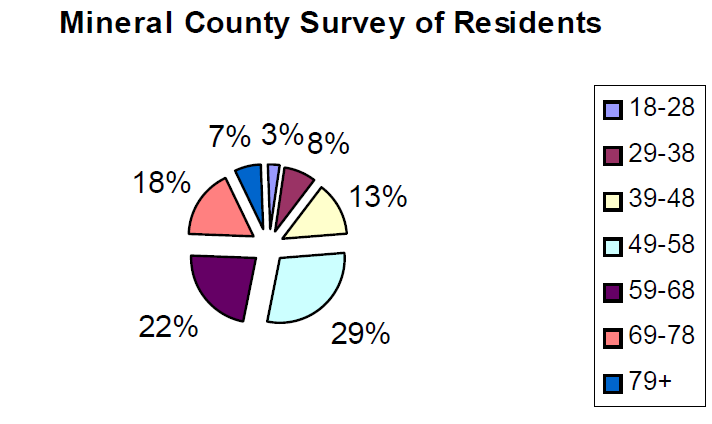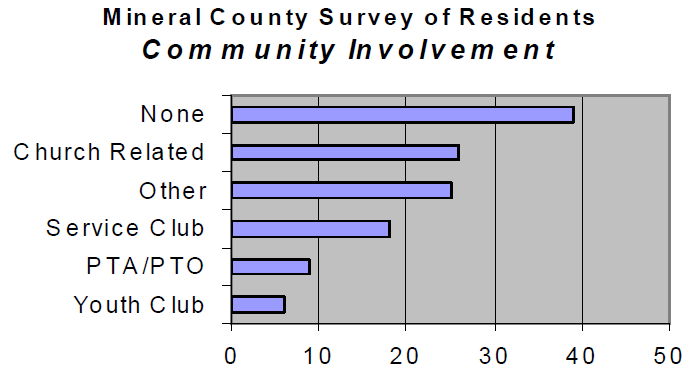Introduction
Mineral County, Created in 1911, is located in West-Central Nevada encompassing about 3,756 square miles. The county is mostly mountainous, with canyons and large arid plateaus rising upward from the Walker Lake Basin. While Hawthorne is the county seat, other small outlying communities existing are Schurz, Walker Lake, Luning and Mina.
The U.S. Census Bureau reported that the population of Mineral County in the 2000 Census was 5,071. The 2002 population of Mineral County, according to the Nevada State Demographer, is the 4,695. The largest unincorporated town is Hawthorne and has an estimated population of 2,995.
Known for its mineral deposits of gold, silver, copper, tungsten, iron, coal, borax, lead and gemstone rocks, the county suffers from the Nevada boom-bust economy. The history of the county not only includes such historical mining areas as Aurora, Candelaria and Bellevue, but is known as the worlds largest U.S. Ammunition Depot and “America’s Patriotic Home.”
This fact sheet reports the results of a need assessment to determine Cooperative Extension programs and priorities in Mineral County. The Extension Educator, once hired, analyzed the data compiled from the survey instrument and gathered fact sheets resulting from the needs assessment report on community needs and issues, and youth development.
Needs Assessment
A formal needs assessment was completed by the University of Nevada Cooperative Extension Northeast Central Area to identify Cooperative Extension programming needs for the geographical area within the boundaries of Mineral County. A needs assessment was completed using a survey instrument which solicited opinions, ideas and perceptions about community problems and even possible solutions from Mineral County residents.
The needs assessment consisted of a survey instrument that comprised 540 households located in Mineral County. There were 207 households that responded containing about 440 individuals including 88 children. The survey instrument integrated 27 sets of questions identifying community involvement, needs, issues, quality of life, youth issues, and demographic characteristics. The results were first compiled by the University Center for Economic Development in order to facilitate the qualifications needed for the Mineral County Extension Educator position. The additional data through public meetings, newspapers, minutes from meetings and any other additional information available.
Demographic highlights
The respondents living in Mineral County were asked a series of questions regarding homeownership, residency and community involvement. Additional demographic information was also asked regarding age, gender and employment. The results provide a unique picture of Mineral County residents. Refer to Chart 1 for an age breakdown of respondents.
The majority of respondents were over the age of 49 years-old. There were 96 percent of respondents that were full-time residents of Mineral County and 50 percent of respondents had lived in Mineral County for 22 years of more. Over half (52.7%) had lived only in Nevada before moving to Mineral County. There were 12 percent of respondents that came from California to Mineral County and 23% of respondents came from another location within the United States. There was only 1% that came from a county outside the United States.
There were 84 percent of respondents that own or are buying their home with 98% having their primary residence in Mineral County. Half of the respondents (50%) had lived in their present home 11 years or more. However, the average number of years that respondents lived in their present home was 15.6 years.
The age of respondents is a direct tie to the number of adults in the household, number of children in the household and the number of adults employed outside the home on a full-time or part-time basis. Only 30 percent of households responding had one adult in the household. Fifty-three percent of respondents had tow adults living in a household and 8 percent had three or four adults per household. Overall, 69 percent of these households did not have any children living at home. There were 26 percent of the respondents that indicated that they had children living at home, and 22 percent of respondents indicated that the children were between the ages of 8-18 years old.
Close to half (49%) of the adults reported in the respondents' households were not employed fulltime or part-time outside the home. There were 26 percent of the respondents that indicated one adult was employed full-time or part-time outside the home, and 22 percent of respondents households indicated that 2 adults were employed outside the home.
Chart 1. Age distribution of survey respondents

There were 75% of the 207 respondents that were over the age of 49 years old. There were 63% female respondents and 35% male respondents. (2% did not answer.)
Data From Chart 1
Community Involvement and Hobbies
Over a third (39%) of the 207 respondent household was not involved in any community organizations or projects. There were 26 percent that indicated they were involved in church-related activities. Only 6 percent indicated that they were involved with a youth club. However, respondents indicated that their top four hobbies were reading (57 percent), gardening (47 percent), fishing (37 percent), and cooking (37 percent). Refer to Chart 2 for a breakdown of community involvement.
Conclusions
The data analysis of the 207 household respondents draws a demographic picture of Mineral County. The majority of the respondents that participated in the needs assessment was at or above retirement age and were most likely retired. The majority of respondent also did not have children living I the primary residence.
The survey results also indicated that a number of residents have lived in Mineral County for years (22 years or more) and own their own home. In addition, it was interesting that most of the respondents had moved to Mineral County from another location in Nevada (52.7 percent). There was also a segment (12 percent) that had moved in from California and others (23 percent) that had moved from another location in the United States.
The data obtained from the survey of residents can be useful to explore and target certain areas of Extension Program interests in the county. While surveys are scientific tools in research and gather accurate and useful information that are used to identify characteristics, it is important to remember that sample surveys present close estimates, not absolutes, and are one tool of many that are used to make assessments of a sample population. The uniqueness of Mineral County demographics will be one tool of many to assets in designing Cooperative Extension programs for the county.
Chart 2. Breakdown by percentage of community involvement of survey respondents

Data From Chart 2
References
Fadali, Betsy, Jerry Buk, and Thomas R. Harris. Mineral County Survey of Residents. University Center for Economic Development, University of Nevada, Reno, University Center for Economic Development Technical Bulletin, UCED 2003/04-30, 2004.
Mineral County Chamber of Commerce. Welcome to American’s Patriotic Home!. Web Address: Mineral County Site.
Salant P., and Dillman D. 1994 How to Conduct Your Own Survey. New York: John Wiley & Sons, Inc.
Schultz, B. 2003. Humboldt County Needs Assessment: Youth. University of Nevada Cooperative Extension Fact Sheet. FS-03-57.
Singletary L. 2000. Lyon County Needs Assessment. University of Nevada Cooperative Extension Fact Sheet. FS-00-33.
State of Nevada Demographer, Nevada Small Business Development Center. 2003. Web Address: SBDC.
Chart 1. Age distribution of survey respondents
| Age group |
Percentage |
| 18-28 |
3% |
| 29-38 |
8% |
| 39-48 |
13% |
| 49-58 |
29% |
| 59-68 |
22% |
| 69-78 |
18% |
| 79+ |
7% |
Chart 2. Breakdown by percentage of community involvement of survey respondents.
| Category |
Percentage |
| None |
39% |
| Church Related |
26% |
| Other |
25% |
| Service Club |
18% |
| PTA/PTO |
9% |
| Youth Club |
6% |
Emm, S.
2004,
Mineral County Needs Assessment: Community Development,
Extension | University of Nevada, Reno, FS-04-61


